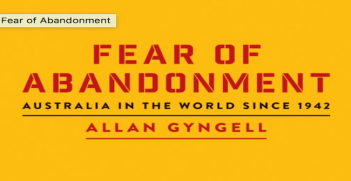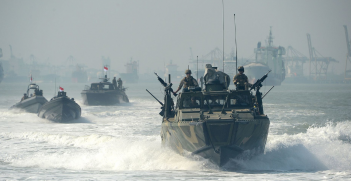What We Learned in 2019: Morrison’s Foreign Policy

In 2019, Morrison outlined his views on the Indo-Pacific as a region of utmost importance. In reviewing Morrison’s foreign policy stance, it is useful to compare with other leaders in the region
It’s the time when we reflect on the year in international affairs. In the Australian political scene, Scott Morrison has given a series of post-election speeches that have coalesced into what some describe as the “Morrison Doctrine” on Australian foreign policy. He has laid out his views on Australia’s place in the region and on US-China rivalry starting with a speech to Asialink in June.
What, then, are Morrison’s views? And how do they compare with speeches given by other regional leaders in a year dominated by a Sino-American trade war?
Morrison’s Perspective
Scott Morrison gave his first post-election foreign policy address to Asialink and Bloomberg in June setting out the principles guiding his Government’s engagement with Asia:
“The Indo-Pacific is where we live. It is where we have our greatest influence and can make the most meaningful impact and contribution. It is the region that will continue to shape our prosperity, security and destiny.”
He farewells the idea of Australia’s geography as a burden. With Asia accounting for two-thirds of global growth and home to more than half the world’s population, “Where else would Australia want to be?”
He recognises that the region is undergoing profound change, particularly as the balance between strategic engagement and competition in US-China relations has shifted, something he describes as “inevitable” given that China’s economic miracle has made it “a significant power.”
This has led to a strain in the “world’s most important bilateral relationship.” Trade tensions have escalated and the collateral damage is spreading, to the detriment of the whole region: “It is in no-one’s interest in the Indo-Pacific to see an inevitably more competitive US-China relationship become adversarial in character.”
Morrison rejects the “fatalism of increased polarisation” which sees these issues only “through a binary prism.” He recognises the positive effect of China’s rise and is determined that the Australia-China relationship “not be dominated by areas of disagreement” but “designed always to leave large scope for cooperation on common interests.”
At the same time, he recognises that US demands need to be dealt with: “It is now evident that the US believes that the rule-based trading system – in its current form – is not capable of dealing with China’s economic structure and policy practices.” He thus advocates for an “urgent repair” of the rules-based system to account for China reaching a new “threshold level of economic maturity” (at this point stopping short of recognising China as a developed country).
Importantly he calls on both the US and China to exercise their responsibilities and “resist a narrow view of their interests.” He asks for a commitment to a rules-based international order, particularly the global trading system. He is speaking to the US as much as China when he says “we will be more secure and prosperous in a global order based on agreed rules, not one based on the exercise of power alone.”
Finally, he sees an active, engaged Australia as a country of influence that should be involved in resolving tensions: “We should not just sit back and passively await our fate in the wake of a major power contest.” Australia should be working together with other countries in the region to mitigate risks, “exercising our regional agency” in the belief that “like-minded nations can take measures to help shape their own destiny.” He outlines how Australia is “working more closely than ever before with close partners like Japan, India, Indonesia and Vietnam” within a vision of the Indo-Pacific that “has ASEAN at its core”.
These themes have continued in the prime minister’s speeches, with the most significant change being a progression in his views on whether China can still be considered a developing country. At the Chicago Institute on Global Affairs in September he noted that as nations progress and develop, then the obligations that apply to them also shift. In his Lowy Lecture in October he said that describing China as “a newly developed economy” is “a compliment, not a criticism.” (We’ll leave aside the other parts of his Lowy Lecture on negative globalism as perhaps a product of a UN Leaders’ Week being hectored on climate change).
To summarise, the emerging Morrison perspective on Australia in its region seems to be that:
- Australia’s security, prosperity and destiny reside in the Indo-Pacific region;
- Great powers can be competitors rather than inevitable adversaries;
- Australia should actively exercise its influence together with others to maintain an order based on rules rather than power.
The reaction to these speeches on Australia’s role in the Indo-Pacific has been mostly positive (in contrast to the almost uniformly hostile reaction to the Lowy speech on negative globalism). Former AIIA National President John McCarthy congratulated the Prime Minister for “taking this stuff seriously” while current President Allan Gyngell described the series of speeches as “thoughtful.” AIIA Fellow Tony Walker gave credit for “seeking to define a way forward” and James Curran commended the attempt to help Australians “adjust to the ever more complex strategic circumstances dominating this century.”
Asian Perspectives
How does Morrison’s view of the current Sino-American rivalry compare to that of other leaders in the region? Comparing three Southeast Asian leaders facing similar issues is instructive.
Thailand is grappling with the same issue of rivalry between its top trading partner and its defence ally. Speaking at an ASEAN Business Summit, while Prime Minister Prayut Chan-o-cha refrained from directly criticising either China or the US, he expressed concern that the “trade conflict between major powers has affected the global trade and investment climate, and may lead to an eventual trade war.” In response, he committed to “maintain ASEAN centrality in the regional architecture amidst major power competition in the region” and said that Thailand would focus on expediting the Regional Comprehensive Economic Partnership trade agreement, now agreed upon.
Malaysia too is reacting to great power rivalry. In his speech launching Malaysia’s Foreign Policy Framework, Prime Minister Tun Dr Mahathir Bin Mohamad described multilateralism as under threat with “powerful countries unilaterally imposing their will on others,” not respecting trade agreements and “blatantly disregarding” the multilateral framework. He commits Malaysia to an “independent, principled and pragmatic foreign policy founded on the values of peace, humanity, justice, and equality.” To achieve this, Malaysia will “not stick to the traditional methods of engagements and instead proactively seek to explore new approaches.”
Singapore, a country that trades with China but has military cooperation with the United States, has been active in calling on countries to find a solution to the ongoing trade war. At the Shangri-La Dialogue, Prime Minister Lee Hsien Loong said that “there is no irreconcilable ideological divide between the US and China” and urged them “to work together, and with other countries too, to bring the global system up to date, and to not upend the system.” Lee celebrated China’s economic achievements and argues that as a corollary, China “can no longer expect to be treated the same way as in the past when it was much smaller and weaker.” He asks what countries can do collectively to stem the growing hostility and notes that states like Singapore are not entirely without agency: “There are many opportunities for smaller countries to work together to deepen economic cooperation, strengthen regional integration, and build up multilateral institutions. This way, we can strengthen our influence as a group”.
This quick tour shows that – while there are differences both in tone and substance – there are also convergences between Morrison and the views of other leaders in the region. There is a desire to avoid either/or choices among great and powerful friends. There is a shared view that conflict is not inevitable. And there is a desire for smaller and middle powers to work together to exercise their influence, both bilaterally and through regional forums.
Looking ahead to 2020, it’s likely that Morrison’s views will continue to develop alongside other countries finding their way in a region shaped by great power rivalry. Let’s hope that Prime Ministers Morrison and Lee are correct in saying that while it may be natural for two powers to vie for power and influence, competition need not inevitably lead to conflict.
Melissa Conley Tyler FAIIA is Director of Diplomacy and Rhiannon Arthur is a former intern at Asialink at The University of Melbourne. Melissa was recently honoured as a Fellow of the Australian Institute of International Affairs in recognition of her distinguished contribution to international affairs. She tweets at @MConleytyler.
This article is published under a Creative Commons Licence and may be republished with attribution.





